Dive Into Ambon; Maluku Resort & Spa, IndonesiaContents of this Issue: Dive Into Ambon; Maluku Resort & Spa, Indonesia Eight-Hour Ordeal for Shark Attack Victim, Craig DeWit You’d Better Have Blank Pages in that Passport MV Valentina. Sea of Cortez, Baja, Mexico Swimming with La Paz Whale Sharks Wes Skiles Verdict Unlucky for Some In-Water Recompression? Our Readers React Sri Lanka Aggressor Postscript Big Sharks Spotted Off Florida’s Atlantic Coast Can Dolphins Save Vaquita Porpoises from Extinction? That Devil Gas Is Not So Dangerous! Coming Soon: Texting While Diving Editorial Office: Ben Davison Publisher and Editor Undercurrent 3020 Bridgeway, Suite 102 Sausalito, CA 94965 a psychedelic experience without drugs from the February, 2017 issue of Undercurrent
Dear Fellow Diver: I returned from my first day of diving off the island of Ambon to find a big, red-haired Viking from Finland I'll call Aleksi regaling our congenial dive hosts, a big, easy-going former Londoner, Kaj (pronounced "Kai") Maney and his vivacious Aussie partner, Barb Makohin. The table before him was littered with empty bottles of "Big" Bintang beer. The grinning Finn explained that he possessed the directions to find an ultra-rare psychedelic frogfish, first discovered in 2009. He had flown in for a few days on news that the frogfish had returned. He had reconnoitered the location and was now happy to share it with Kaj, a long-time friend.
Our two guides gave me plenty of reasons to be flying high, skillfully pointing out such critters as delicately colored nudibranchs, a juvenile painted frogfish, lacy ribbons of eggs, a spiny devilfish, and many others I have yet to identify -- the Tropical Pacific Reef Fish Identification book labels some fish as simply "undescribed." The two other sites we dove that day were Laha III and Laha I, both in 30 to 40 feet of water near a turn in the bay that sheltered a small fleet of local fishing boats. The currents were crazy. Because of the locals' habit of tossing trash into the ocean, the bottom held a sandy swirl of "cultural artifacts" that made for challenges when photographing the giant frogfish, Pikachu nudibranch, rhinopias, leaf fish, ornate ghost pipefish, flatworms and schools of scadfish. By day's end, my camera card was loaded with 350 photos, almost exclusively creatures and fish, since hard and soft corals were scarce on these sandy-bottomed muck dives. (Bob Halstead, that Aussie curmudgeon, gets credit for coining the term "muck dives.) That night the assembly of international divers converging on Dive Into Ambon grew as Austrian husband-wife dive photography/writing team Wolfgang and Barbara Poelzer booked in. They could not have timed their arrival better. The next day we found a male psychedelic frogfish in a coral hole, not far from the female, which carried a dozen marble-sized eggs tucked against her body with her tail. Thanks to my 105mm Nikon macro lens, I could see pairs of little eyes and pale white stripes on little pink bodies inside the eggs. I should note that the water ranged between 80F and 83F during the entire trip. With my full 5mil and hooded vest with booties -- pretty much the same as our guides -- staying down for as long as 85 minutes posed no problem. Many of our dives were gentle drifts. We explored Laha II for our second dive, again in some unpredictable currents, and this time I added a gaudy harlequin shrimp, an "undescribed" arminid nudibranch sporting two-toned purple bulbous cerata, and a tiny estuary seahorse to my catalog of "first sightings." I gave myself a mental slap upside the head when, after I spotting a skittish wonderpus, its brown arms ringed with white bands, I considered that the sighting was great, but not all that "exceptional" compared to the other rarities I was seeing. I was getting far too spoiled!
The remaining hotel rooms -- sort of roomy, motel-like rooms -- are in a twostory building facing a big freshwater pool and an open air restaurant and garden area with a flowing brook. Two larger units closer to the bay are dubbed the Sea View studio rooms. For a reasonable upcharge, we booked a separate thatched-roof tri-level cottage. A king-sized bed and desk/ vanity sat on the upper level. A smaller living area on the main level held a free-standing air conditioner, coffee table, chair and couch. Sliding glass doors opened to a cozy front porch big enough to hold a gear drying rack, table, and two chairs. On the lower level, the large, attractive bathroom was partially open to the air, adding to the one-with-nature experience. I showered standing on shale surrounded by pebbles, while amusing little crabs skittered around my feet. But, the room had no potable water, occasionally the power went out, it took a while for the water to heat up, and going up and down the steps at night to use the bathroom was annoying. These inconveniences melted away in the evening while sipping sundowners on our porch with a view of the bay.
The cast of divers flying in for the psychedelic experience grew as a Chinese beauty named Jovin checked in. She constantly surfs the web for reports of unusual finds, she said, and after seeing reports of the frogfish, she immediately flew in from Singapore to get photographs. The next day, she and a young Aussie couple dove on the resort's other boat, while the Austrians and I boarded the roomy 45-foot Mimicus (a fully covered boat powered by two Evinrude 250HP outboards). I stretched my dives at Panti Nama Wall and Panti Nama Slope to 80 minutes to capture a rare hairy octopus, pink lobed mantis, and a poison mototi (aka ocellate) octopus that displayed a single iridescent blue ring under each eye. Getting back into the boat was not easy, as the steep ladder had narrow rungs and no outboard grip. So, I doffed my weights and BCD/tank and let the eager young crew lift everything up. They would check each diver's computer, writing down remaining psi and deepest depth. My deepest was 82 feet, while most were less than 60 feet. While the coral and terrain had some appeal -- there is better coral in Indonesia -- the main reason for making the trek to Ambon is spotting rare and weird creatures and fish. Besides the diving that day, I gathered wide-ranging cultural impressions -- floating refuse that tangled in our props, women on motorbikes garbed in hajibs, and cattle grazing next to the road, cheek by jowl with the busy town center of Paso less than two miles from our resort. That night Kaj treated us to an afterdinner presentation of his world-class underwater videography, some of which has been featured in NatGeo specials.
Their three-dives-per-day dive routine suited me well. In the morning I'd grab a coffee and have an omelet with homemade bread and fresh fruit and either climb into the shuttle to the jetty at Ambon Bay or wade out to the boat off the resort. Either way, we'd be in the water between 9:30 and 11. Briefings were bare-bones and in broken English, but covered the essentials. After the first two dives, we'd eat a lunch (rice, fish or chicken, fruit and salad with a cookie or three) in the boat's roomy covered cabin, which had four tables and seating for about 16, then dive again, and be back to the resort between 3 and 4 pm. The staff carried my gear from the boat and rinsed and stored everything. My last two dives that day were off Hukurila, a district facing the Banda Sea on the island's south side, where there seemed to be more hard and soft coral. I watched a hairy squat lobster whose spiky white hairs made its tiny purple legs and claws looked like a colorful miniature bottle brush. A green-hued dragon shrimp hid between thin tips of a black coral, the reddish spikes on its back reminding me somewhat of a rhinoceros beetle. After a picnic on the beach near a small waterfall of trash spilling over a sandy ledge, we explored the underwater Hukurila Cave. At dinner that night Jovin observed that among those in the know, Ambon was becoming the "new Lembeh," but much less crowded. Others agreed as we dove into a dessert of chocolate-covered pastries dipped in coconut.
That night, we motored carefully to Frangy's Point, with Joel using a strong flashlight to dodge families fishing in rowboats without lights. The dive was in a shallow sandy patch with outstanding visibility. Raised in Ambon and the surrounding islands, divemasters Alan and Joel scouted ahead like bloodhounds. After shooting in one spot, I'd look for a circle of lights in the distance, then rejoin the others. I spotted an uncommon bobtailed squid about two inches long that stays buried by day. Shrimp and prawn scurried by, burying quickly when lit up. A juvenile flathead skimmed the bottom, followed by a helmet conch on the prowl. A blunt nose pipe horse and small mollusks ranged in search of food, the mollusks probing with long, extended mouth tubes. A blenny snake eel, partially hidden in the sand, emerged far enough to get a clear close-up. To say that I didn't want to come up after 70 minutes would be an understatement. My hunch is that most of what I experienced in Ambon, other than the psychedelic frogfish, would be there if I returned. Odds are more favorable for spotting a hairy octopus, the mototi species of the blue-ringed octopus, wonderpus and "undescribed" nudibranch. I also feel that I "discovered" a reasonably priced, clean boutique resort with decent food and a dive center run by an incredibly talented and energetic couple. Kaj and Barb made each new day an adventure, followed by a jolly feast at day's end. The somewhat mysterious and decidedly exotic setting, plus an enjoyable international mix of fellow divers, made my stay with Dive Into Ambon/Maluku Resort & Spa a really good trip. -- S.P. Our undercover diver's bio: S.P. says, "Learning to scuba (35 years ago), my beavertail neoprene wetsuit got me through my YMCA silver-level certification, even if I did freeze my bippy during 100-foot descents onto Great Lakes freighters. I've gradually earned all the main certifications, including Master Scuba Diver, and I have an SDI/TDI/ ERDI solo diving certification that comes in handy when I am sometimes left on my own on dives while taking photos. In between frequent dive trips, from the Caribbean to the Asia Pacific, I am a public safety diver and try to dive once a week year-round when our local lakes are not frozen over, and when they, are I'm ice diving."
|

I want to get all the stories! Tell me how I can become an Undercurrent Online Member and get online access to all the articles of Undercurrent as well as thousands of first hand reports on dive operations world-wide
| Home | Online Members Area | My Account |
Login
|
Join
|
| Travel Index |
Dive Resort & Liveaboard Reviews
|
Featured Reports
|
Recent
Issues
|
Back Issues
|
|
Dive Gear
Index
|
Health/Safety Index
|
Environment & Misc.
Index
|
Seasonal Planner
|
Blogs
|
Free Articles
|
Book Picks
|
News
|
|
Special Offers
|
RSS
|
FAQ
|
About Us
|
Contact Us
|
Links
|
3020 Bridgeway, Ste 102, Sausalito, Ca 94965
All rights reserved.

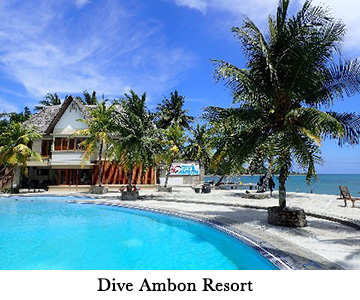 The next morning Aleksi pointed out a stand of palms
to triangulate the "secret" spot. Within minutes, I
beheld the pink- and white-striped psychedelic frogfish --
a mesmerizing peppermint swirl of color straight out of
a '60s Jefferson Airplane poster -- not seen since 2014,
and before that, not since it was discovered in Ambon on
the north rim of the Banda Sea. Taking turns, the three
other divers patiently waited while I enjoyed photographic ecstasy with my all-purpose Nikon 60mm macro lens. She
was a female behaving in typical frogfish manner, staring
fixedly upward, nestled in a protected nook.
The next morning Aleksi pointed out a stand of palms
to triangulate the "secret" spot. Within minutes, I
beheld the pink- and white-striped psychedelic frogfish --
a mesmerizing peppermint swirl of color straight out of
a '60s Jefferson Airplane poster -- not seen since 2014,
and before that, not since it was discovered in Ambon on
the north rim of the Banda Sea. Taking turns, the three
other divers patiently waited while I enjoyed photographic ecstasy with my all-purpose Nikon 60mm macro lens. She
was a female behaving in typical frogfish manner, staring
fixedly upward, nestled in a protected nook.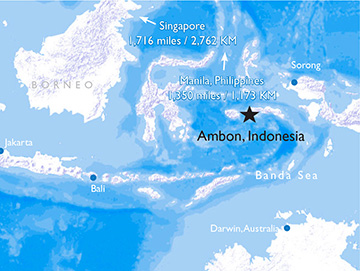 Dive Into Ambon is located at Maluku Resort & Spa, a boutique-sized enclave
that sits between the main drag and water's edge on Baguala Bay. Four individual
cottages line one side of the property, ending in an attractive building that
houses the dive shop, a well-laid-out, dedicated camera room and a nice spa on the
second floor. The multi-stalled camera room is far larger than their retail shop,
which offers dive-oriented jewelry, fish and creature ID books, mask straps and
T-shirts, and a large range of dive rental gear.
Dive Into Ambon is located at Maluku Resort & Spa, a boutique-sized enclave
that sits between the main drag and water's edge on Baguala Bay. Four individual
cottages line one side of the property, ending in an attractive building that
houses the dive shop, a well-laid-out, dedicated camera room and a nice spa on the
second floor. The multi-stalled camera room is far larger than their retail shop,
which offers dive-oriented jewelry, fish and creature ID books, mask straps and
T-shirts, and a large range of dive rental gear.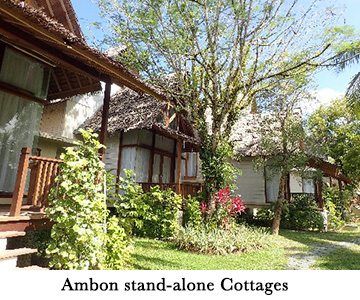 That night at dinner with Kaj, Aleksi, Wolfgang and his spouse, Barbara,
I was on cloud nine, and not just because of the big Bintangs or the ouzo that
Barbara discreetly shared after dinner. Family-style dinners had memorable dishes
made with coconut, such as their chicken curry and coconut pie, but they also
served delicious roasted chicken and fish steamed in banana leaf. They didn't
scrimp on the deserts, which ranged from a watermelon sorbet to banana splits to
a lemon soufflé. The Islamic hotel owners serve no alcoholic beverages, but the
"foreign-run" Dive Into Ambon saved the day. They sell beer ($4.50 for a 650 ml
Indonesian Big Bintang, $3 for a Filipino San Miguel) and Hatten Aga Red wine from
Bali ($27.50/bottle), which my non-picky spouse enjoyed. And Barb often served
home-made appetizers with the beer and wine in front of the pool before dinner.
That night at dinner with Kaj, Aleksi, Wolfgang and his spouse, Barbara,
I was on cloud nine, and not just because of the big Bintangs or the ouzo that
Barbara discreetly shared after dinner. Family-style dinners had memorable dishes
made with coconut, such as their chicken curry and coconut pie, but they also
served delicious roasted chicken and fish steamed in banana leaf. They didn't
scrimp on the deserts, which ranged from a watermelon sorbet to banana splits to
a lemon soufflé. The Islamic hotel owners serve no alcoholic beverages, but the
"foreign-run" Dive Into Ambon saved the day. They sell beer ($4.50 for a 650 ml
Indonesian Big Bintang, $3 for a Filipino San Miguel) and Hatten Aga Red wine from
Bali ($27.50/bottle), which my non-picky spouse enjoyed. And Barb often served
home-made appetizers with the beer and wine in front of the pool before dinner.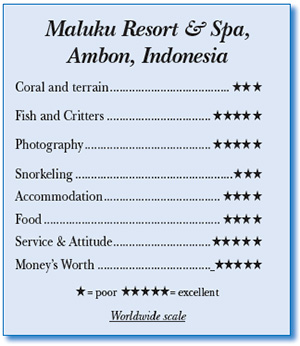 The following day, Mimicus slogged against choppy two-foot waves as we worked
our way back to its dry-season home on Baguala Bay in front of the resort (the
shop continued to run its smaller boat from Ambon Bay). In an underwater canyon at
Alfa Point, we stayed within sight of sunlight as we moved into an opening in a
seaside wall and stood inside in the open air on a shelf. We turned off our lights
to watch hundreds of flashlight
fish put on a spectacular display.
They have bioluminescent bacteriafilled
patches under their eyes,
which they can control to give
the effect of brightly blinking.
Alas, I didn't get a single
photo. That morning I had changed
lenses on my camera without testing
it. When I tried to turn my
camera on underwater, it refused.
The following day, Mimicus slogged against choppy two-foot waves as we worked
our way back to its dry-season home on Baguala Bay in front of the resort (the
shop continued to run its smaller boat from Ambon Bay). In an underwater canyon at
Alfa Point, we stayed within sight of sunlight as we moved into an opening in a
seaside wall and stood inside in the open air on a shelf. We turned off our lights
to watch hundreds of flashlight
fish put on a spectacular display.
They have bioluminescent bacteriafilled
patches under their eyes,
which they can control to give
the effect of brightly blinking.
Alas, I didn't get a single
photo. That morning I had changed
lenses on my camera without testing
it. When I tried to turn my
camera on underwater, it refused. 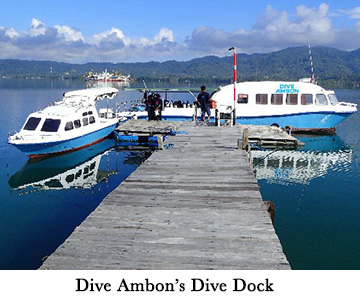 On my last diving day, my spouse and I waded out to the boat. Our first stop was the tiny island called Pulau Pombo where we dove a shallow reef in the Haruku
Strait. While my spouse and two other women -- teachers traveling from New Zealand
and Australia -- went on a guided snorkeling foray, I explored a site called Hard
Boiled. At 82 feet, my favorite divemaster, Joel, opened a mesh bag filled with
hard boiled eggs; he peeled and ate one, feeding the rest to the fish. My spouse
saw lots of reef fish and enjoyed her pleasant snorkeling trip.
On my last diving day, my spouse and I waded out to the boat. Our first stop was the tiny island called Pulau Pombo where we dove a shallow reef in the Haruku
Strait. While my spouse and two other women -- teachers traveling from New Zealand
and Australia -- went on a guided snorkeling foray, I explored a site called Hard
Boiled. At 82 feet, my favorite divemaster, Joel, opened a mesh bag filled with
hard boiled eggs; he peeled and ate one, feeding the rest to the fish. My spouse
saw lots of reef fish and enjoyed her pleasant snorkeling trip. Diver's Compass: Deluxe cottage for eight nights and six days of
three dives/day with three meals/day was $1799 for me as a diver
plus $699 for my nondiving spouse, with a $58/person shuttle fee
for the 50-minute ride from Pattimura International Airport on
Ambon to the resort ... $90 for Nitrox for the week, and $50 for
the night dive ... They asked for c-cards ... Tipping was pooled;
we gave about $260 to the dive shop and $100 to the hotel ...
Flights from the Midwest were through Narita, Japan, then Jakarta,
with RT prices at $1976 pp ... Ambon is driest October through
April, and the chamber on its naval base is open to the public in
case of emergencies ... BYO distilled spirits; you won't find them easily on this
Muslim-oriented island ... We saved our land excursions for Jakarta (using the
hotel's concierge) and Narita/Tokyo (prearranged with Narita Rainbow Tours) for on
the way home ... U.S. Dollars and credit cards were accepted in Indonesia, but no
traveler's checks ... Electric current is 220v with two-pin round plugs; Maluku
has complimentary internet access ... We liked the Sheraton Bandara in Jakarta
(about $150/night) and Hotel Nikko Narita (about $125/night) ... We like keeping
our local dive shop in business, and they worked through Caradonna to set up the
entire trip, which made things much easier. Web sites:
Diver's Compass: Deluxe cottage for eight nights and six days of
three dives/day with three meals/day was $1799 for me as a diver
plus $699 for my nondiving spouse, with a $58/person shuttle fee
for the 50-minute ride from Pattimura International Airport on
Ambon to the resort ... $90 for Nitrox for the week, and $50 for
the night dive ... They asked for c-cards ... Tipping was pooled;
we gave about $260 to the dive shop and $100 to the hotel ...
Flights from the Midwest were through Narita, Japan, then Jakarta,
with RT prices at $1976 pp ... Ambon is driest October through
April, and the chamber on its naval base is open to the public in
case of emergencies ... BYO distilled spirits; you won't find them easily on this
Muslim-oriented island ... We saved our land excursions for Jakarta (using the
hotel's concierge) and Narita/Tokyo (prearranged with Narita Rainbow Tours) for on
the way home ... U.S. Dollars and credit cards were accepted in Indonesia, but no
traveler's checks ... Electric current is 220v with two-pin round plugs; Maluku
has complimentary internet access ... We liked the Sheraton Bandara in Jakarta
(about $150/night) and Hotel Nikko Narita (about $125/night) ... We like keeping
our local dive shop in business, and they worked through Caradonna to set up the
entire trip, which made things much easier. Web sites: 